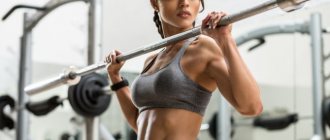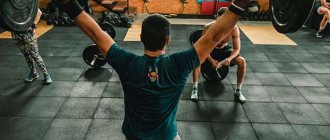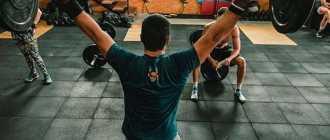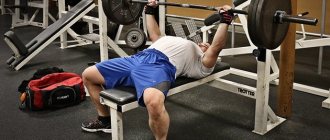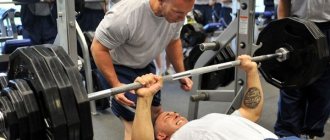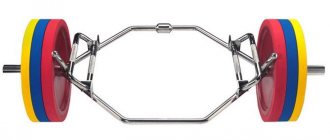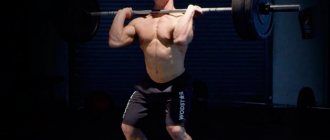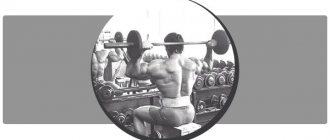Barbell bars are versatile equipment that are an essential tool for strength training. Devices differ in appearance and shape depending on the purpose for which they are used, size and weight. For effective training, it is important for a person to know the features of using this tool.
How much does a barbell weigh?
There are several types of bars that differ in purpose and technical characteristics: length, diameter, and of course, weight. There are straight and curved bars, some are suitable for basic exercises and are placed on the shoulders (squats) or used in deadlifts, while others (curves) are intended only to be held in the hands. On average, straight professional bars weigh 15-20 kg, excluding locks, and curved bars weigh about 6-7 kg.
Why do you need to have information about shells?
It is very important to have information about what types of barbells there are. Surely many people do not understand how important this is. In fact, this is very important to know. A person who wants to achieve high results must know everything about the area in which he strives to achieve success. It’s hard to imagine that world bodybuilding champions don’t know how much a particular piece of equipment weighs.
This is the moment when knowledge helps not only in achieving results, but also in maintaining health. There are an incredible number of examples when a person comes to the gym and grabs everything. You can often notice that he weighs 60 kilograms, but does not know anything about the barbell itself. As a result, he will get injured, because heavy weight has a bad effect on unprepared joints.
When it comes to deadlifts and squats, maintaining an accurate weight is incredibly important. In general, these are all words, but the fact remains that before going to the gym, you need to familiarize yourself with the weight of individual sports elements.
Types of barbells
There are several types of straight chrome bar: Olympic bar for weightlifting, powerlifting and special for women. They are used for basic exercises: squats, deadlifts, barbell presses, and the like.
Olympic bar
The bushings on this plate bar rotate, which is important for weightlifting exercises that require jerking.
The neck rod has notches. Options:
- Weight – 20kg.
- 2 locks – each 2.5 kg.
- The neck diameter is 20 mm.
- Length – 2200 mm.
- Total weight with locks – 25 kg.
Olympic bar for women
This type of straight bar differs from the previous one in size and weight.
- Weight – 15 kg.
- Length – 2050 mm.
- Diameter – 25 mm.
Powerlifting bar
This bar has slight differences from the Olympic bar: the length of the bar is 2200 cm, but the diameter is 29 mm, and the weight is also 20 kg. Withstands heavy loads.
Trap neck
A hexagonal or hexagonal bar is designed for deadlifting. It replaces the Olympic bar and shifts the load to the quadriceps. By holding the bar in your hands, as opposed to a straight bar, you can avoid compressive stress on the spine.
EZ-neck
A curved bar is essential for exercising the arm muscles, especially the biceps. The special shape of the bar is able to remove excess stress from the wrists, which greatly facilitates the technique and makes it anatomically more comfortable for the joints.
- Neck length – 1200 mm.
- Weight – 6500 grams.
W-shaped neck
The curved bar is very similar to the ez-shaped bar visually and in technical characteristics, but is designed specifically for performing the French press, namely for the triceps. You can also perform biceps and forearm exercises with this bar.
Parallel grip bar
Another common name is oval. Necessary for a parallel (neutral) grip, which provides an anatomically comfortable load on the biceps and forearms. This variety can replace the two previous options for working out the arm muscles.
Universal bar (home non-professional)
These options are found in home equipment lines. A straight bar allows you to select the load for all muscle groups, but the technical characteristics must be selected depending on your physical fitness. Typically, such equipment is of poorer quality, but also costs much less.
- The length of the neck is from 1250 to 2000 cm.
- Weight – from 6 to 10 kg.
P-neck
An unusual and custom U-shaped bar that enhances the range of motion in the bench press that cannot be achieved with an Olympic bar. The special shape of the bar allows you to lower your arms lower, thereby stretching the pectoral muscles more, and this, in turn, will improve the appearance and accelerate the growth of the pectoral muscles.
- Weight: 20 kg.
- Length: 225 cm.
- Protrusion height: 35 cm.
Bar with rotating knobs
This invention is designed to provide additional supination of the biceps and pronation of the triceps, which is simply not possible with a conventional barbell lift. Rotating handles inside rings on bearings provide free rotation of the hand, as if working with dumbbells.
- Length: 120 cm.
- Weight: 12 kg.
Hatfield Vulture
Weightlifter and powerlifter Frederick Hatfield, who invented this design, once suffered a shoulder injury, after which he could not train with a regular bar. Thanks to this, his invention was born. A bar with a shifted center of gravity provides both comfort and safety at the same time, and increases the load on the quadriceps. Special rollers do not put pressure on the shoulders, and the shift in the center of gravity does not overload the shoulder and knee joints.
- Weight: 35-40 kg.
- Length: 225 cm.
Weight
When discussing what types of barbells there are, one cannot help but touch upon the topic of the weight of this apparatus. Its weight directly depends on its size - the longer it is, the heavier it is. On average, the weight of a metal rod for a barbell ranges from 6 to 30 kilograms. Particular attention should be paid to the locks that are attached to both sides of the bar to secure the pancakes. The standard weight of locks is 2.5 kilograms.
As already noted, there are many types of vultures. Each of them differs in size, weight and functionality. How many varieties of vultures are there? What are their names? Which one is the best?
The best barbell manufacturers
Iron King
Russian manufacturer of sports and rehabilitation equipment. The company appeared 15 years ago and has earned credibility in the market of sports equipment and exercise equipment. Iron King guarantees the safety of its products and high quality, despite the relatively low cost. Depending on the type of neck, prices vary from 1,300 to 7,000 rubles.
IDOL Action
The manufacturer produces lines of various types of necks. Among them are:
- Godzilla 20kg competition powerlifting bar, 29mm diameter;
- Olympic bar Tiger, weighing 20 kg with bearings;
- as well as a women's Olympic bar weighing 15 kg with bearings with a diameter of 25 mm.
Cost from 11,700 – 14,000 rubles.
Rogue Fitness
The US brand produces sports equipment, including the men's Olympic bar weighing 20 kg, with a diameter of 28.5 mm, a top seller in Russia. Approximate cost from 13,000 rubles.
For home workouts
Home workouts are very popular these days. You can begin to strengthen your muscles gradually, first using dumbbells, which also vary in weight and technical design.
In order not to buy new dumbbells, each time increasing the working weight, you can purchase collapsible ones. A training kit can be represented by two barbells, four spring locks and a set of discs (1.2 or more kilograms).
In order to create a training weight, you need to know how much the dumbbell bar weighs. Its weight is 2 kilograms. The locks are lightweight, each weighing 0.1 kilograms.
Tref and axel type
The bench press bar should not only be comfortable, but also provide the desired base load without weights. Traf is considered one of the basic group of weights for the back muscles. To perform this, the athlete stands as if inside the bar and lifts it, giving an even load on the muscles of the arms, as well as to pump up the muscle corset on the back. The optimal weight is up to 15 kg, and the length is about 160 cm. It is used to perform shrugs.
The axel is a type with a wide diameter and is intended for developing grip strength. Due to the large diameter, it is difficult to hold the bar, which creates a lot of stress on the arms and makes it difficult to perform basic exercises.
Using barbells to pump up muscles gives a quick effect. But it is necessary to combine different types of load so that all muscle groups develop evenly.
Errors during execution
A classic mistake when working with a barbell is the wrong grip. It makes it harder to complete and reduces efficiency. You need to take it so that your thumb is on the opposite side from the other four and the bar fits snugly in your hand.
The second mistake is the lack of an adjustment frame. Without it, it will be difficult to hold a lot of weight on your own, unless the trainer is constantly on the side for protection.
Beginning athletes can raise their pelvis above the bench, which not only makes the process more difficult, but can also lead to injury. During the press, the back should serve as a support for the body. Without this, doing it can harm the body.
Returning the barbell incorrectly to the rack when using a bench press bar can end badly for the performer, as the weight of the bar can cause serious injury. During the return process, you need to see both the rack itself and the bar - it is placed at eye level. It must be returned gradually, slowly lowering it onto the fasteners.
If the elbows are not secured to the fasteners, the muscles can quickly be inflated to the desired size, but this can be dangerous for the athlete, since the soft tissues will tire faster and it will not be possible to perform the exercises efficiently.
Using simple tips and recommendations from trainers will help you not only avoid mistakes, but also get a beautiful and toned body in a short period of time.
Tips for beginners
When you come to the gym for the first time, under no circumstances should you grab the first equipment you come across; you need to ask the coach for advice. But, first of all, you need to decide for yourself the purpose of training and develop a training plan. This will help avoid injuries and funny situations.
Don't be afraid to ask. But it is important to understand what you are asking! That is, you should not ask the question: “How much does a standard barbell weigh?” This formulation is incorrect and amateurish.
Varieties and types
For training and obtaining maximum results, various devices and elements can be used. Vultures are considered the most popular and versatile. They can be used both for strength training and for tightening the figure and performing exercises for individual muscle groups.
You can also use additional loads with barbells if you need to pump up your muscles. To perform standard exercises, elements without pancakes are suitable. Highlight:
- straight Olympic bar;
- powerlifting;
- ordinary straight element;
- parallel grip bar;
- W-shaped.
Choosing the right bar for the bench press guarantees high-quality results and load efficiency. Regularly doing the right exercises will help you achieve a beautiful and slim figure.
